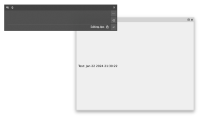-
Bug
-
Resolution: Cannot Reproduce
-
P3: Somewhat important
-
6.6
-
None
-
Chrome under Windows 10 and 11
This is about the WebAssembly platform when running under Chrome in Windows 10 and 11.
When using a pen tablet (e.g. a Wacom device), tapping the pen anywhere on a window (including the shadows, border and title bar) causes the Windows handwriting panel to spring up unexpectedly and disrupt whatever the user actually wants to do.
I've attached a screenshot where I tapped on the (light) window and it opened up the (dark) handwriting panel. The window is just a bare QMainWindow with a QLabel in its central widget.
I've traced this to the canvas element of the window having contenteditable="true" on it, which gets set in wqasmwindow.cpp line 78:
// Set contenteditable so that the canvas gets clipboard events,
// then hide the resulting focus frame.
m_canvas.set("contentEditable", std::string("true"));
I've hacked around this by removing the contenteditable attribute from the canvas element and instead setting tabindex="-1" on it. This still allows it to accept focus and get key events, but no longer triggers the handwriting panel. As far as I can tell, I can still use the clipboard to copy and paste text, but I'm not sure if that covers everything.
(To add insult to injury, the panel can't actually be used to input text into any text fields. I don't know of any user that wants to handwrite text with their drawing tablet though, they want to draw with it and not get interrupted by the annoying panel.)
